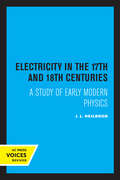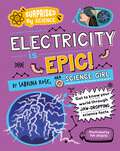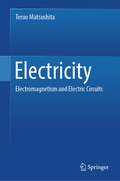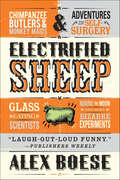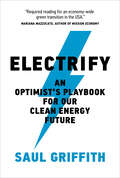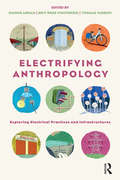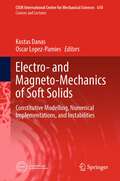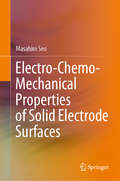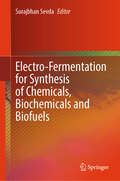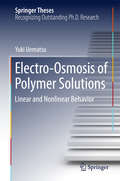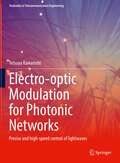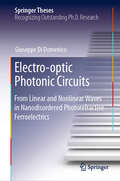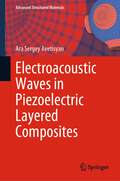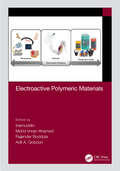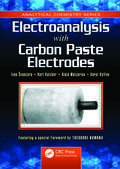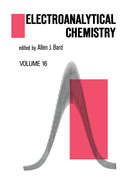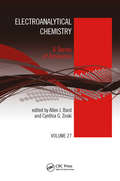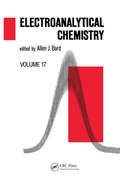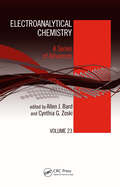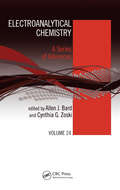- Table View
- List View
Electricity in the 17th and 18th Centuries: A Study of Early Modern Physics
by J. L. HeilbronThis title is part of UC Press's Voices Revived program, which commemorates University of California Press’s mission to seek out and cultivate the brightest minds and give them voice, reach, and impact. Drawing on a backlist dating to 1893, Voices Revived makes high-quality, peer-reviewed scholarship accessible once again using print-on-demand technology. This title was originally published in 1979.
Electricity is Epic! (Surprised by Science #6)
by Sabrina Rose Science GirlBe surprised by the astonishing science of electricity, with Sabrina Rose, AKA Science Girl, the internet's most inspiring curator of facts and observations of our wonderful world - making it easy for all readers to come to love science!Surprised by Science: Electricity is Epic brings an attention-grabbing and accessible set of electricity facts to life! Doing what she's famous for online, Sabrina Rose dives into the most surprising details of the world of electricity to explore the science at work. From lightning strikes to shocking static; from aurora in the sky to electricity in the human body - this series is perfect for inquisitive children age 7 and up, and all fans of Science Girl.Contents: What is Electricity? / The Spark of Discovery / The Power of the Sun / All Charged Up / The Perfect Storm / Electricity in Us / Supercharged Creatures / An Electrifying Connection / Electrical Spectacle / Natural Wonders / Plug It In / Surprised by Scientific Discoveries: Franklin & Edison / Surprised by Scientific Discoveries: Tesla & Faraday / Glossary and Further Information / IndexSurprised by Science is a series of books that takes the inspiring communication and research skills of Science Girl's hugely popular platform and distills it on the page, with funny and engaging illustrations by Pipi Sposito paired with photos of the real-life science in action. The series includes: Electricity is Epic!; Plants are Powerful!; Forces are Fantastic!; Sound is Sensational!; Animals are Awesome!; Human Bodies are Brilliant!
Electricity: Electromagnetism and Electric Circuits
by Teruo MatsushitaThis book leads students to learn electromagnetism and then moves to chapters about electric circuits. It aims to give an understanding of electromagnetism which gives a fast way to master the features of circuit elements such as resistors, capacitors, and coils that compose electric circuits. The author provides chapters on electromagnetism and electric circuits separately and gives a chapter explaining the correlation between them in detail.In the chapters for electric circuit, DC electric circuits, transient and steady response of AC electric circuits are treated. AC circuit theory is introduced for describing the phenomena in circuits. Theoretical treatments such as branch current method, closed current method, and node potential method are also introduced to show the validity of solution methods that have been used in the book. The book can serve as a compact textbook for lectures, as an introduction for hardware system and electric control systems, and mechanical systems. Chapters for electromagnetism or ones for electric circuits are suitable for a lecture over a semester.
Electrified Sheep: Glass-eating Scientists, Nuking The Moon, And More Bizarre Experiments
by Alex Boese"Perfect summertime reading—preferably with a friend nearby who can be constantly interrupted with unsettling facts." —Daily Mail (UK )Benjamin Franklin was a pioneering scientist, leader of the Enlightenment, and a founding father of the United States. But perhaps less well known is that he was also the first person to use mouth-to-mouth resuscitation on an electric-shock victim. Odder still, it was actually mouth-to-beak resuscitation on a hen that he himself had shocked. Welcome to some of the weirdest and most wonderful experiments ever conducted in the name of science. Filled with stories of science gone strange, Electrified Sheep is packed with eccentric characters, irrational obsessions, and extreme experiments. Watch as scientists attempt to nuke the moon, wince at the doctor who performs a self-appendectomy, and catch the faint whiff of singed wool from an electrified sheep.
Electrify: An Optimist's Playbook for Our Clean Energy Future
by Saul GriffithAn optimistic--but realistic and feasible--action plan for fighting climate change while creating new jobs and a healthier environment: electrify everything.Climate change is a planetary emergency. We have to do something now—but what? Saul Griffith has a plan. In Electrify, Griffith lays out a detailed blueprint—optimistic but feasible—for fighting climate change while creating millions of new jobs and a healthier environment. Griffith&’s plan can be summed up simply: electrify everything. He explains exactly what it would take to transform our infrastructure, update our grid, and adapt our households to make this possible. Billionaires may contemplate escaping our worn-out planet on a private rocket ship to Mars, but the rest of us, Griffith says, will stay and fight for the future. Griffith, an engineer and inventor, calls for grid neutrality, ensuring that households, businesses, and utilities operate as equals; we will have to rewrite regulations that were created for a fossil-fueled world, mobilize industry as we did in World War II, and offer low-interest &“climate loans.&” Griffith&’s plan doesn&’t rely on big, not-yet-invented innovations, but on thousands of little inventions and cost reductions. We can still have our cars and our houses—but the cars will be electric and solar panels will cover our roofs. For a world trying to bounce back from a pandemic and economic crisis, there is no other project that would create as many jobs—up to twenty-five million, according to one economic analysis. Is this politically possible? We can change politics along with everything else.
Electrifying Anthropology: Exploring Electrical Practices and Infrastructures (Criminal Practice Ser.)
by Brit Ross Winthereik Thomas Yarrow Simone Abram Anjan SarkarWhat kinds of expertise and knowledge relate to electricity, and where is the space for alternative voices? How can the new roles for electricity in social and cultural life be acknowledged? How can we speak about ‘it’ in its own right while acknowledging that electricity is not one thing? This book re-describes electricity and its infrastructures using insights from anthropology and science and technology studies, raising fascinating questions about the contemporary world and its future. Through ethnographic studies of bulbs, bicycles, dams, power grids and much more, the contributors shed light on practices that are often overlooked, showing how electricity is enacted in multiple ways. Electrifying Anthropology moves beyond the idea of electricity as an immovable force, and instead offers a set of potential trajectories for thinking about electricity and its effects in contemporary society. With new contributions on an emerging area of research, this timely collection will be of value to students and scholars of anthropology, science and technology studies, geography and engineering.
Electrifying Atmospheres: Charging, Ionisation and Lightning in the Solar System and Beyond
by Karen L. AplinElectrical processes take place in all planetary atmospheres. There is evidence for lightning on Venus, Jupiter, Saturn, Uranus and Neptune, it is possible on Mars and Titan, and cosmic rays ionise every atmosphere, leading to charged droplets and particles. Controversy surrounds the role of atmospheric electricity in physical climate processes on Earth; here, a comparative approach is employed to review the role of electrification in the atmospheres of other planets and their moons. This book reviews the theory, and, where available, measurements, of planetary atmospheric electricity, taken to include ion production and ion-aerosol interactions. The conditions necessary for a global atmospheric electric circuit similar to Earth's, and the likelihood of meeting these conditions in other planetary atmospheres, are briefly discussed. Atmospheric electrification is more important at planets receiving little solar radiation, increasing the relative significance of electrical forces. Nucleation onto atmospheric ions has been predicted to affect the evolution and lifetime of haze layers on Titan, Neptune and Triton. For planets closer to Earth, heating from solar radiation dominates atmospheric circulations. Mars may have a global circuit analogous to the terrestrial model, but based on electrical discharges from dust storms, and Titan may have a similar global circuit, based on transfer of charged raindrops. There is an increasing need for direct measurements of planetary atmospheric electrification, in particular on Mars, to assess the risk for future unmanned and manned missions. Theoretical understanding could be increased by cross-disciplinary work to modify and update models and parameterisations initially developed for a specific atmosphere, to make them more broadly applicable to other planetary atmospheres. The possibility of electrical processes in the atmospheres of exoplanets is also discussed.
Electro- and Magneto-Mechanics of Soft Solids: Constitutive Modelling, Numerical Implementations, and Instabilities (CISM International Centre for Mechanical Sciences #610)
by Kostas Danas Oscar Lopez-PamiesThis book examines the electro- and magneto-mechanics of soft composite materials and structures, and focuses on magnetorheological elastomers (MREs) and dielectric elastomer composites (DECs), which are composite materials that comprise ferromagnetic and high-dielectric/conducting filler nano- and micro-particles embedded in a soft polymeric matrix. This gives rise to a coupled magneto- and electro-mechanical response at the macroscopic (order of millimeters and larger) scale when they are subjected to magneto- electro-mechanical external stimuli. While such MRE and DEC materials and devices can become unstable at some critical electro-magneto-mechanical loading, their response may be well controlled in the post-instability regime. Moreover, recent advances on the complete electro-magneto-mechanical coupling are presented. All those aforementioned features motivate the operation of these devices in this unstable region to obtain controlled pattern formation, soft robotic motion andartificial muscles, controllable band-gap acoustic and electromagnetic properties, energy harvesting as well as actively controlled stiffness (for cell-growth). The book contains four individual chapters covering work on the fundamentals (O. Lopez-Pamies) and the modeling (M. Gei) of electroactive solids, the modeling of magnetoactive solids (K. Danas), and the analysis of elastic instabilities (Y. Fu).
Electro-Chemo-Mechanical Properties of Solid Electrode Surfaces
by Masahiro SeoThis book deals with the electro-chemo-mechanical properties characteristic of and unique to solid electrode surfaces, covering interfacial electrochemistry and surface science. Electrochemical reactions such as electro-sorption, electro-deposition or film growth on a solid electrode induce changes in surface stress or film stress that lead to transformation of the surface phase or alteration of the surface film. The properties of solid electrode surfaces associated with the correlation between electrochemical and mechanical phenomena are named “electro-chemo-mechanical properties”. The book first derives the surface thermodynamics of solid electrodes as fundamentals for understanding the electro-chemo-mechanical properties. It also explains the powerful techniques for investigating the electro-chemo-mechanical properties, and reviews the arguments for derivation of surface thermodynamics of solid electrodes. Further, based on current experimental findings and theories, it discusses the importance of the contribution of surface stress to the transformation of surface phases, such as surface reconstruction and underpotential deposition in addition to the stress evolution during film growth and film reduction. Moreover, the book describes the nano-mechanical properties of solid surfaces measured by nano-indentation in relation to the electro-chemo-mechanical properties. This book makes a significant contribution to the further development of numerous fields, including electrocatalysis, materials science and corrosion science.
Electro-Chemo-Mechanics of Solids
by Sean R. Bishop Nicola H. Perry Dario Marrocchelli Brian W. SheldonThis book brings together a collection of chapters that focus on the relationship among electrical, chemical, and mechanical properties and the study of adjusting one property through the control of another, namely, Electro-Chemo-Mechanics (ECM). The authors examine how this relationship can result in beneficial properties, such as mixed ionic and electronic conductivity, in oxides, upon oxygen deficiency or lithium insertion (electro-chemo) and/or changes in ionic and electronic mobility observed in strained systems (electro-mechano). They also consider how ECM interactions can be responsible for large stresses from non-stoichiometry induced lattice dilation (chemo-mechano). While many volumes are available devoted to the study of the origins and characteristics of electro-chemical relationships, they form the well-known field of electrochemistry, this volume is highly novel in its examination of the corresponding electro-mechanical, chemo-mechanical, and electro-chemo-mechanical relationships. The book is ideal for researchers and design engineers interested in energy storage and conversion and the electrical and mechanical properties of materials.
Electro-Fermentation for Synthesis of Chemicals, Biochemicals and Biofuels
by Surajbhan SevdaThis book covers the basics and applied aspects of electro-fermentation and their applications in synthesizing various bio-products. It combines principles of electrochemistry and fermentation to produce valuable chemicals, biochemicals and biofuels. It also includes examples of these synthesized products such as organic acids, alcohols, hydrogen and biopolymers. The topics covered include recent advancements in electrode materials, synthetic biology integration and scale-up efforts. The book is a valuable reference for beginners, researchers and professionals interested in bioprocess engineering, biochemical engineering, environmental engineering and allied fields.
Electro-Osmosis of Polymer Solutions
by Yuki UematsuThis thesis focuses on the theoretical description of electro-osmosis of polymer solutions. In particular, it emphasizes the importance of considering non-uniform profiles of the solution viscosity and polymer concentration near a solid surface. The thesis begins with an introduction to fundamental theories and experimental observations for beginners in this field, concerning electrolyte solutions, electric double layers, and electrokinetics. In Chapter 2, the author discusses the linear response of electro-osmotic flow with respect to applied electric fields in aqueous polyelectrolyte solutions, and predicts a possibility of flow reversal caused by oppositely charged polyelectrolytes adsorbed on a charged surface. In Chapter 3, the author extends the discussion to non-linear electro-osmotic flow driven by applied electric fields in neutral polymer solutions. The dynamics of polymers are modeled and simulated using Brownian dynamics and kinetic theory. Finally, the thesis is summarized in Chapter 4. The introduction provides a comprehensive review of electrokinetics for graduate students and researchers interested in soft matter physics. An additional attraction is that readers can effectively learn various theoretical approaches to electro-osmosis.
Electro-optic Modulation for Photonic Networks: Precise and high-speed control of lightwaves (Textbooks in Telecommunication Engineering)
by Tetsuya KawanishiThis textbook provides comprehensive and detailed information on electro-optic modulation, which plays important roles in lightwave networks including optical fiber links, visible ray communications, fiber-wireless, etc. The first part of this book describes roles and basic functions of optical modulators as well as various modulation schemes. The second part is on mathematical expressions dedicated to optical modulation, where sideband generation are clearly described. In conclusion, this book provides useful information for device and system technologies, and helps in understanding fundamental issues on telecommunication systems as well as electro-optic devices. Contents in this book provide valuable information for engineering students in telecommunications. It also gives useful examples of applied mathematics using Bessel functions. It is ideal for upper undergraduate and graduate level classes.Provides comprehensive mathematical expressions dedicated to optical phase modulation based electro-optic effect;Presents practical knowledge of optical modulators as well as basic theory on modulator operation;Includes classroom materials including software and PowerPoint slides for easy integration into curriculum.
Electro-optic Photonic Circuits: From Linear and Nonlinear Waves in Nanodisordered Photorefractive Ferroelectrics (Springer Theses)
by Giuseppe Di DomenicoThis book reports new findings in the fields of nonlinear optics, quantum optics and optical microscopy. It presents the first experimental device able to transform an input Gaussian beam into a non-diffracting Bessel-like beam. The modulation mechanism, i.e. electro-optic effect, allows the device to be fast, miniaturizable and integrable into solid state arrays. Also presented is an extensive study of the superposition of Bessel beams and their propagation in turbid media, with the aim of realizing field that is both localized and non-diffracting. These findings have been implemented in a light-sheet microscope to improve the optical sectioning. From a more theoretical point of view this work also tackles the problem of whether and how a single particle is able to entangle two distant systems. The results obtained introduce fundamental limitations on the use of linear optics for quantum technology. Other chapters are dedicated to a number of experiments carried out on disordered ferroelectrics including negative intrinsic mass dynamics, ferroelectric supercrystals, rogue wave dynamics driven by enhanced disorder and first evidence of spatial optical turbulence.
Electroacoustic Waves in Piezoelectric Layered Composites (Advanced Structured Materials #182)
by Ara Sergey AvetisyanThis book deals concisely and coherently with various issues related to electroacoustic waves in piezoelectric layered composites.Starting with the basic linear equations and relations of electromagnet elasticity of homogeneous anisotropic piezoelectric media, the book considers the conditions for possible field or partial conjugation of physical and mechanical fields at the junction of two homogeneous media with geometrically homogeneous surfaces. The variety of electromechanical boundary conditions and the separation of plane and anti-plane fields of elastic deformation in homogeneous piezoelectric crystals are discussed.Then, the statements of the electroacoustic problem in piezo textures are studied and a layered piecewise-homogeneous piezoelectric waveguide is introduced, with non-acoustic contact between different piezoelectric layers.Non-acoustic contact between different piezoelectric layers can lead to the propagation of a hybrid of electroactive waves of plane and anti-plane elastic deformations.In the last part of the book, the problem of controlling electroacoustic waves in a waveguide is formulated. A method for solving problems of control of electroacoustic waves by non-contact surface action is proposed.
Electroactive Polymeric Materials
by InamuddinElectroactive polymers are smart materials that can undergo size or shape structural deformations in the presence of an electrical field. These lightweight polymeric materials possess properties such as flexibility, cost-effectiveness, rapid response time, easy controllability (especially physical to electrical), and low power consumption. Electroactive Polymeric Materials examines the history, progress, synthesis, and characterization of electroactive polymers and then details their application and potential in fields including biomedical science, environmental remediation, renewable energy, robotics, sensors and textiles. Highlighting the flexibility, lightweight, cost-effective, rapid response time, easy controllability, and low power consumption characteristics of electroactive polymers, respected authors in the field explore their use in sensors, actuators, MEMS, biomedical apparatus, energy storage, packaging, textiles, and corrosion protection to provide readers with a powerhouse of a reference to use for their own endeavors. Features: Explores the most recent advances in all categories of ionic/electroactive polymer composite materials Includes basic science, addresses novel topics, and covers multifunctional applications in one resource Suitable for newcomers, academicians, scientists and R&D industrial experts working in polymer technologies .
Electroanalysis with Carbon Paste Electrodes (Analytical Chemistry)
by Ivan Svancara Kurt Kalcher Alain Walcarius Karel VytrasBecause of their simple preparation and low expense, carbon pastes and carbon paste electrodes are widely used in a myriad of instrumental measurements. With an emphasis on practical applications, Electroanalysis with Carbon Paste Electrodes provides a comprehensive overview of carbon paste electrodes. The text offers a comprehensive and unpreceden
Electroanalytical Chemistry (A Series of Advances #Vol. 16)
by Allen J. BardThis volume provides authoritative reviews in the field of modern electroanalytical chemistry defined in its broadest sense. It is valuable to practicing analytical chemists interested in learning about and applying electroanalytical techniques.
Electroanalytical Chemistry: A Series of Advances, Volume 27 (Electroanalytical Chemistry: A Series of Advances #20)
by Allen J. Bard Cynthia G. ZoskiThis volume is part of a continuing series that provides authoritative reviews on recent developments and applications of well-established techniques in the field of electroanalytical chemistry. Each volume provides the necessary background and starting point for graduate students undertaking related research projects and is of special interest to practicing analytical chemists concerned with electroanalytical techniques. Volume 27 continues this tradition with innovative contributions from internationally respected scientists who highlight new technologies and trends in Protein Biosensing, Bipolar Electrochemistry, and X-ray Absorption Spectroscopy in Electrochemistry.
Electroanalytical Chemistry: A Series of Advances: Volume 15 (Electroanalytical Chemistry: A Series Of Advances Ser.)
by Allen J. BardThis book is designed to provide authoritative reviews in the field of modern electroanalytical chemistry defined in its broadest sense. It is helpful to practicing analytical chemists interested in learning about and applying electroanalytical techniques.
Electroanalytical Chemistry: A Series of Advances: Volume 17
by Allen J. BardThis book examines the metal/solution interface with the electrochemical quartz crystal microbalance, exploring electrostatic adsorption, metal deposition, and roughness. It explores the indirect laser-induced temperature-jump method for characterizing fast interfacial electron transfer.
Electroanalytical Chemistry: A Series of Advances: Volume 22 (Electroanalytical Chemistry: A Series Of Advances Ser. #Vol. 22)
by Allen J. Bard; Israel RubinsteinFor more than three decades the Electroanalytical Chemistry series has delivered the most in-depth and critical research related to issues in electrochemistry. Volume 22 continues this gold-standard with practical reviews of recent applications, as well as innovative contributions from internationally respected specialists highlighti
Electroanalytical Chemistry: A Series of Advances: Volume 23
by Allen J. Bard Cynthia G. ZoskiElectroanalytical chemists and others are concerned not only with the application of new and classical techniques to analytical problems, but also with the fundamental theoretical principles upon which these techniques are based. With the advent of nanotechnology and the drive to create sustainable eco-friendly products, electroanalytical technique
Electroanalytical Chemistry: A Series of Advances: Volume 24 (Electroanalytical Chemistry: A Series of Advances)
by Allen J. Bard Cynthia ZoskiFor more than three decades the Electroanalytical Chemistry Series has delivered the most in-depth and critical research related to issues in electrochemistry. Volume 24 continues this gold-standard with practical reviews of recent applications as well as innovative contributions from internationally respected specialists who highlight the emergenc
Electroanalytical Chemistry: A Series of Advances: Volume 25 (Electroanalytical Chemistry: A Series of Advances)
by Allen J. Bard Cynthia ZoskiThis volume is part of a continuing Electroanalytical Chemistry Series designed to provide authoritative reviews on recent developments and applications of well-established techniques in the field of electroanalytical chemistry. Electroanalytical techniques are used in such diverse areas as electro-organic synthesis, fuel cell studies, and radical
